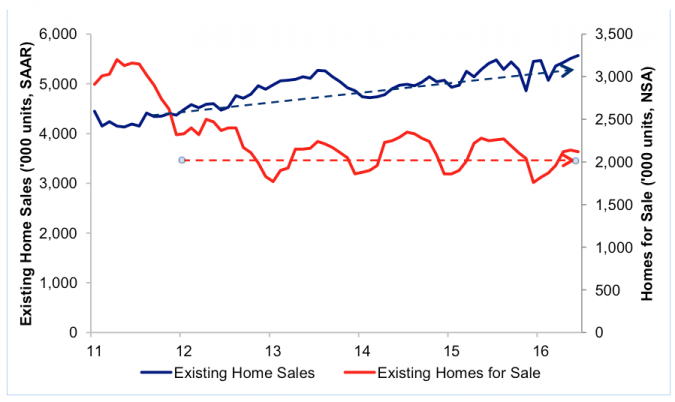Here are two converse facts about the current state of the American housing market: home sales keep rising, while inventories keep falling. How can both of these seemingly opposite market indicators be true?
For the first half of 2016, sales of existing homes are up 5% year over year. In fact in June, home sales reached their highest level since early 2007 with a seasonally adjusted rate of 5.56 million units sold.
But despite this sales boon, inventories are still surprisingly low. In the first several months of 2016 housing inventories remained flat, a positive sign that some experts predicted was indicative of builders and investors finally catching up with demand. Now the numbers are in for the peak of the summer market and the number of existing homes for sale is actually down 130,000 year over year.
These opposing sales and inventories are not not just a blip on the real estate market radar, they in fact represent the continuation of a trend that has been happening since 2012. Over the last three years while inventories have been flat or down, home sales are up by nearly
600,000 units, from 4.67 million units to 5.25 million units sold.
So, what could be causing this abnormal market movement where supply and demand are not influencing the other as expected? There are certainly two sides to any deal and real estate is no exception. The majority of homebuyers aren’t entering the market for the first time and the majority of sellers aren’t leaving it to retire. The average homeowner has to sell their current home prior to buying a new one, regardless of whether they’re up or downsizing or moving across the country.
Hence, the head scratching conundrum of the market’s behavior over the last three to four years. If more homes are being sold, where are the homes for sale to balance that equation? Could all of this be attributed to a rise first time home buyers?
Certainly a glut of first time buyers would shift the trends in these opposite directions. Since first time buyers are entering the market, they obviously don’t have a home to sell first prior to their purchase. But are there other explanations?
Second (and third and fourth and so on…) homes would qualify, as would those purchased by house flippers or larger investment groups. These two types of homebuyers would add sales without raising inventory.
The purchase of “second” or vacation homes has been on the rise as of late, especially since startups like AirBnb have made home rentals much easier and raised exposure of these non-hotel rentals exponentially. Still, buyers purchasing these types of homes are an extremely small slice of the overall market pie.
What about investors? Here in Los Angeles you’d be hard pressed to not find construction in any neighborhood. From Inglewood to the Hollywood Hills, it’s a good time to be a contractor. Tear downs are the norm in non-protected neighborhoods where homes built in the last five years now outnumber the ones that have been there for fifty plus. So on a local level, investors could explain this trend of rising homes sales and falling inventory, but nationally it doesn’t add up.
Speaking of adding up, it looks like we’re going to have to do some math to get to the bottom of this pattern. Let’s leave this to the experts. Here’s Tian Liu of HousingWire.com:
“One way to understand the missing inventory is by comparing actual inventory level with the level of inventory holding constant the months of supply. For example, actual housing inventory in 2015 was around 180,000 units less than the level of inventory if months of supply had stayed at the 2014 level. If more first-time homebuyers in the housing market explains the missing inventory phenomenon, it would have to have a similar size.”
The best way to determine whether a homebuyer is actually a first timer is to study numbers released by the mortgage insurance industry and the FHA. It looks like the FHA and mortgage industry helped almost 1 million new first-time homebuyers in 2015 alone. That’s an increase of nearly 200,000 first time buyers from 2014.
So what does this all mean? It’s actually good news for home sellers and real estate agents and industry professionals as home prices should continue to rise. Even the lower end housing market has seen an uncharacteristic tightening as higher prices have forced buyers, particularly first timers to cast a wide net in order to claim that first rung of the property ladder.
If you’re interested in buying or selling a Luxury Home in Los Angeles, please contact us now at 323-829-8811 or email Susan Andrews at susan@luxurylahomes.com.
Contact us anytime if you ever wonder “What’s my home worth”?
Or visit HollywoodHillsValue.com for a free no obligation home valuation.
